How worried are investors about North Korea? Take a look at the charts
The war of words between the US and North Korea is starting to rattle markets. Don’t be surprised if this rumbles on for a while, says John Stepek.


This week has been dominated by fears over conflict with North Korea. US president Donald Trump and North Korea'sKim Jong-un have been trading insults.
What everyone's a little worried about is that at some point they'll go from trading insults, to trading long-range missiles.
That spectre has started to rattle markets. It seems that the distant threat of nuclear war is just scary enough to penetrate the thick fug of easy money, and the ingrained"buy-the-dip"instinct it has engendered in investors.
MoneyWeek
Subscribe to MoneyWeek today and get your first six magazine issues absolutely FREE

Sign up to Money Morning
Don't miss the latest investment and personal finances news, market analysis, plus money-saving tips with our free twice-daily newsletter
Don't miss the latest investment and personal finances news, market analysis, plus money-saving tips with our free twice-daily newsletter
The closest geopolitical parallel isprobably the Cuban missile crisis in October 1962, althoughfor now, it's a long way from that.But I'm not sure we can draw too many lessons in terms of investment from that particular event.
You see, the Cuban missile crisis barely dented the S&P 500. If you were to look at a chart, you'd have no idea the world was on the verge of ending that month.
I'm sure that'll surprise anyone who lived through it. I wasn't around then. But I've noticed that it's one of the few historic events of the 1960s that everyone who was there can recallprecisely so it was clearly terrifying. Yet the S&P 500 barely blipped.
This might be partly because stocks had sold off hardin thefirst half of 1962, so they'd already had a (non-related) crash that year, and investors probably weren't in the mood for another.
Today, markets are a lotmore expensive and it's certainly been a long time since we've seen a bear market. So as I say, I'm not sure the Cuban missile crisis is a useful parallel from an investment point of view.
Anyway, like all geopolitical events, this one will rattle and unnerve the markets until they have a better idea of the path forward. It's hard to say what that might be. And in the meantime, markets have been looking for a good excuse to sell off. So don't be surprised if this rumbles on for a bit.
Right, over to the charts.
Gold
Given that gold is the Armageddon asset of choice, you'd think would make gains, and that's just what happened.
Gold had taken a major knock last week after the US employment data beat expectations, but that was more than reversed this week.
By the way, the key level on gold, from a charting point of view, is $1,295 per ounce. If it can get back above that level (known as resistance'), that suggests the rally has legs. So keep an eye on it.
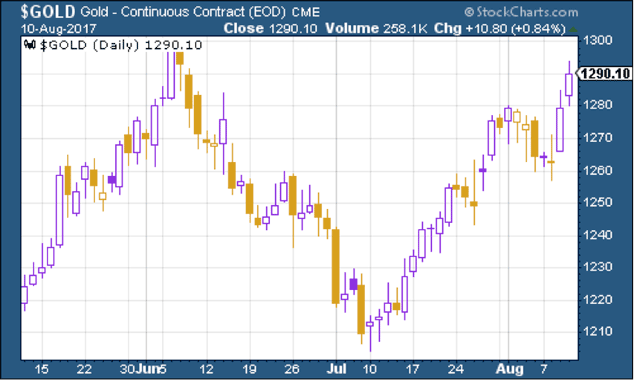
(Gold: three months)
US dollar
Second, the US dollar index continued to rebound. That's unusual when combined with a rise in gold prices, but it's basically a sign that the market wants to invest in "safe havens".
There aresaferthings than the US dollar the very safest havens (from the market's perspective)include the Swiss franc, the Japanese yen, US Treasuries, German bunds, and gold. But when things get scary, the dollar does tend to rise against the majority of other assets.
When people are worried,theyseek liquidity. Thedollar offers plenty of that.
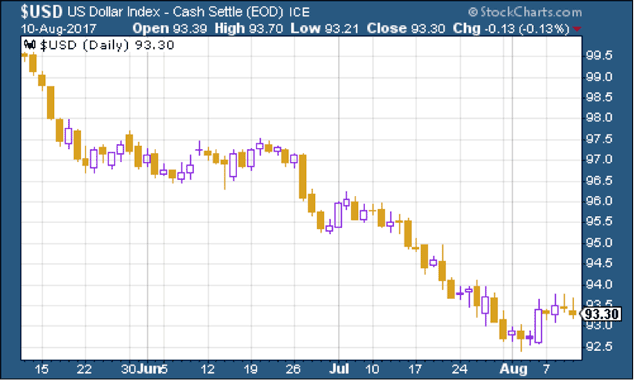
(DXY: three months)
Ten-year US Treasury bonds
On US Treasuries, the ten-year yield fell this week as the price of US Treasury bonds rose. Again, that's demand for safe haven assets at work.
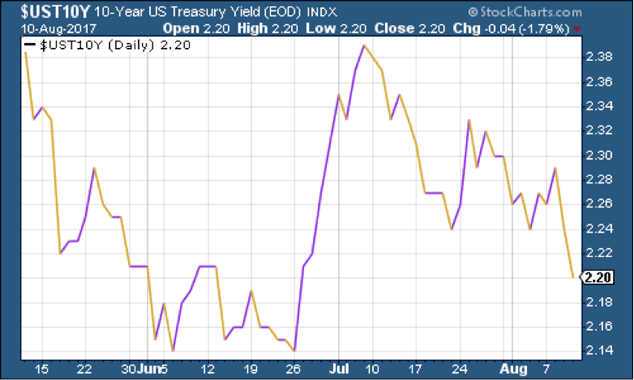
(Ten-year US Treasury: three months)
Copper
Copper had a good run this week, as investors became more optimistic on economic growth (and, I suspect, copper is starting to gain on the back of electric-car mania). But it started to fall prey to jitters towards the end of the week and saw a bit of profit-taking.
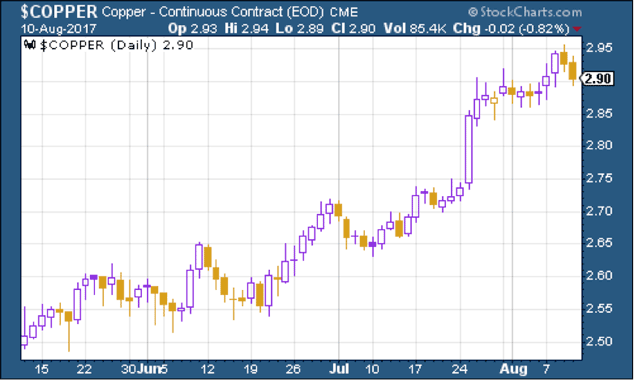
(Copper: three months)
Bitcoin
Bitcoin has had a good week. I'd be reluctant to describe it as a safe haven asset, but the "fork" that created another flavour of bitcoin ("bitcoin cash") appears to have benefited the original version investors are selling their bitcoin cash and buying plain old bitcoins.
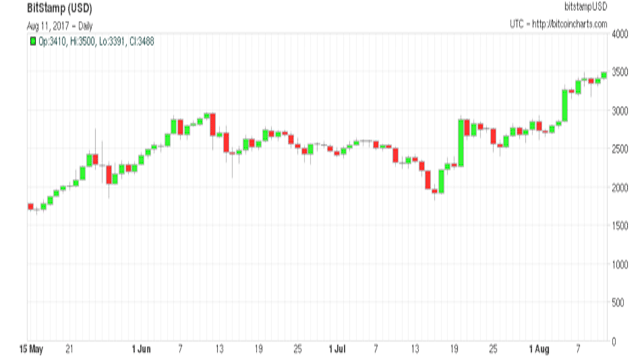
US jobless claims
The weekly US jobless claims data continued to stay strong. According to David Rosenberg of Gluskin Sheff, when this hits a "cyclical trough" (as measured by the four-week moving average), a stockmarket peak is not far behind, and a recession follows about a year later.
This week, US jobless claims came in at 244,000. The four-week moving average edged higher to 241,000, having hit its lowest level of the year on May 20th.
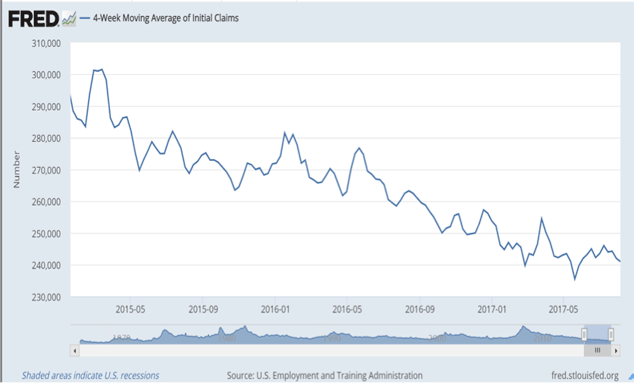
If that holds as the cyclical trough, then if Rosenberg is right (and to be fair, it's a small data set) we might be looking at a stockmarket peak later this year but it looks quite possible that the numbers could get even lower.
Oil price
Chart number seven is the oil price (as measured byBrent crude oil, the international/European benchmark). Oil has edged lower this week, but remained above the $50 a barrel mark.
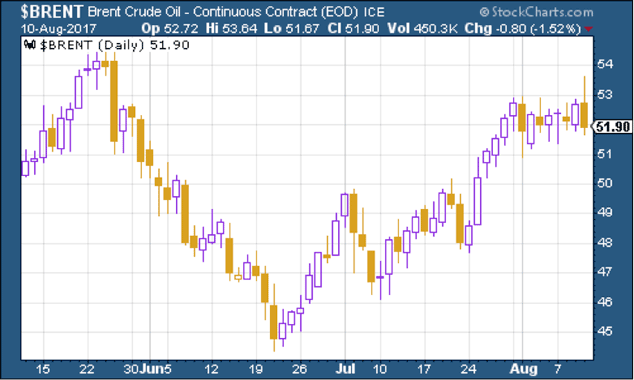
(Brent: three months)
Amazon
Finally there's Amazon. The tech sector giant saw its share price slide this week along with the rest of the market. Is this year's biggest momentum trade going firmly into reverse? Let's see how it looks this time next week.
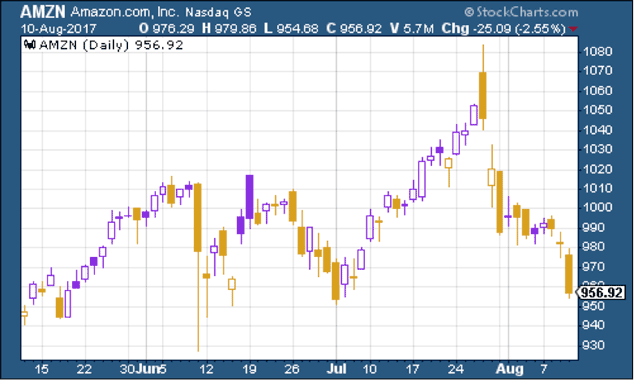
(Amazon: three months)
Get the latest financial news, insights and expert analysis from our award-winning MoneyWeek team, to help you understand what really matters when it comes to your finances.
John Stepek is a senior reporter at Bloomberg News and a former editor of MoneyWeek magazine. He graduated from Strathclyde University with a degree in psychology in 1996 and has always been fascinated by the gap between the way the market works in theory and the way it works in practice, and by how our deep-rooted instincts work against our best interests as investors.
He started out in journalism by writing articles about the specific business challenges facing family firms. In 2003, he took a job on the finance desk of Teletext, where he spent two years covering the markets and breaking financial news.
His work has been published in Families in Business, Shares magazine, Spear's Magazine, The Sunday Times, and The Spectator among others. He has also appeared as an expert commentator on BBC Radio 4's Today programme, BBC Radio Scotland, Newsnight, Daily Politics and Bloomberg. His first book, on contrarian investing, The Sceptical Investor, was released in March 2019. You can follow John on Twitter at @john_stepek.
-
 ISS backs Edinburgh Worldwide’s board as Saba questions SpaceX selloff
ISS backs Edinburgh Worldwide’s board as Saba questions SpaceX selloffShareholder advisor ISS has recommended that shareholders vote against Saba’s proposals to replace the board of the Baillie Gifford-managed investment trust
-
 13 tax changes in 2026 – which taxes are going up?
13 tax changes in 2026 – which taxes are going up?As 2026 gets underway, we look at what lies ahead in terms of changes to tax rates and allowances this year and how it will affect you.
